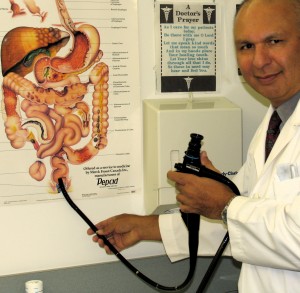Colorectal cancer is the second most commonly diagnosed cancer in Canada and the second leading cause of cancer death. First being lung cancer.
It is estimated about one in 13 men and one in 16 women will be diagnosed with colorectal cancer during their lifetime. Seventy per cent of cancers are in the colon and 30 per cent are in the rectum.
Over the years we have been diagnosing colorectal cancer at an earlier stage thanks to public awareness and the variety of screening tests available to the public. Cancer diagnosed early has about 90 per cent survival rate. Cancer diagnosed in advanced stage has about 10 per cent survival rate.
There are many ways to get the general public involved in the screening programs. The programs can be adjusted to an individual’s needs and fears. Screening tests are purely for people who have no bowel symptoms or family history of colorectal cancer or polyps. For them screening should begin at age 50 and we have a variety of tests to choose from.
Colonoscopy is the most accurate test for detecting colorectal cancer, proven to detect the disease early and save lives. But even a very good test can be done too often, according to experts at Choosing Wisely Canada (CWC). CWC is the national voice for reducing unnecessary tests and treatments in health care. Having a colonoscopy more than once every five or ten years usually isn’t necessary unless there are clear indications. Routine checks usually aren’t needed after age 75.
If a screening colonoscopy does not find adenomas (pre-malignant benign tumours) or cancer and you don’t have risk factors, the next test should be in ten years. If one or two small low-risk adenomas (polyps) are removed, the exam should be repeated in five to ten years.
Some individuals, who are at a low or average risk of colorectal cancer would prefer to go for an alternative test. For whatever reasons, some people do not like the idea of getting a screening colonoscopy. Here are some other choices, though not as good as colonoscopy.
Virtual colonoscopy (CT colonography): During a virtual colonoscopy, a CT scan produces cross-sectional images of the abdominal organs, allowing the doctor to detect changes or abnormalities in the colon and rectum. To help create clear images, a small tube (catheter) is placed inside your rectum to fill your colon with air or carbon dioxide. Virtual colonoscopy takes about 10 minutes and is generally repeated every five years.
Fecal occult blood test or fecal immunochemical test: These are lab tests used to check stool samples for hidden (occult) blood. The tests usually are repeated annually.
Flexible sigmoidoscopy: During flexible sigmoidoscopy, a thin, flexible tube is inserted into the rectum. A tiny video camera at the tip of the tube allows the doctor to view the inside of the rectum and most of the lower part of the colon (sigmoid colon). A flexible sigmoidoscopy test takes about 20 minutes and is generally repeated every 5 years.
Stool DNA test: The stool DNA test uses a sample of your stool to look for DNA changes in cells that might indicate the presence of colon cancer or precancerous conditions. The stool DNA test also looks for signs of blood in your stool.
If any of the above test is positive then you must have a colonoscopy to confirm the findings and manage the problem.
Start reading the preview of my book A Doctor's Journey for free on Amazon. Available on Kindle for $2.99!



